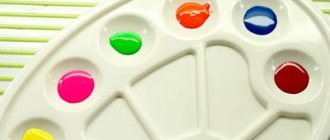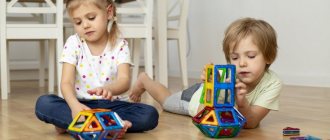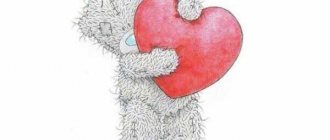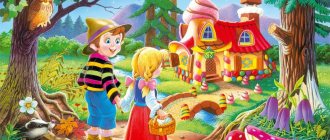A selection of copybooks for children of preschool and primary school age for home study.
Preparing for school is an important stage in the life of every child. And it is very important to start it on time, and most importantly, to show the little person that acquiring new skills is not only a necessary process, but also a very interesting one. You can start learning with the simplest copybooks, which will help develop perseverance, attentiveness, and teach your child how to hold a pen or pencil correctly. Our article presents recipes for children of different ages.
Copybooks for children 3 years old - a selection for home studies
For this age category of children, you need to choose the simplest copybooks that do not require special writing skills. These can be different lines, just familiar objects. The main thing is that there are no very small details; at this age, children still cannot accurately adhere to any specific line. And the smaller the object in the picture, the more difficult it will be for the baby to trace it.
Copybooks for children 3 years old - a selection for homework:
Copybooks for children 3 years old - a selection for home studies
Copybooks for children 3 years old - a selection for home studies
Copybooks for children 3 years old - a selection for home studies Copybooks for children 3 years old - a selection for home studies Copybooks for children 3 years old - a selection for homework
Copybooks for children 3 years old - a selection for home studies
Copybooks for children 3 years old - a selection for home studies
Copybooks for children 3 years old - a selection for home studies
Copybooks for children 3 years old - a selection for home studies
Copybooks for children 3 years old - a selection for home studies
Copybooks for children 3 years old - a selection for home studies
Copybooks for children 3 years old - a selection for home studies
Copybooks for children 3 years old - a selection for home studies
Copybooks for children 3 years old - a selection for home studies
Copybooks for children 3 years old - a selection for home studies
Copybooks for children 4-5 years old - a selection for homework
Starting from the age of 4, children show more interest in drawing, which means that pictures with copybooks can become more complex. For such children, you can make the task more difficult and ask them to stick to the dotted line as accurately as possible. If your child doesn’t succeed, suggest that he first draw short lines from point to point, and when this stage begins to work out, start learning to draw lines more smoothly.
Copybooks for children 4-5 years old - a selection for homework:
Copybooks for children 4-5 years old - a selection for homework
Copybooks for children 4-5 years old - a selection for homework
Copybooks for children 4-5 years old - a selection for homework
Copybooks for children 4-5 years old - a selection for homework
Copybooks for children 4-5 years old - a selection for homework
Copybooks for children 4-5 years old - a selection for homework
Copybooks for children 4-5 years old - a selection for homework
Copybooks for children 4-5 years old - a selection for home studies Copybooks for children 4-5 years old - a selection for homework
Copybooks for children 4-5 years old - a selection for homework
Copybooks for children 4-5 years old - a selection for home studies Copybooks for children 4-5 years old - a selection for homework
Copybooks for children 4-5 years old - a selection for homework
Copybooks for children 4-5 years old - a selection for homework
Copybooks for children 4-5 years old - a selection for homework
What a perfect copy it is
The registration must contain:
- various forms and topics of classes;
- in addition to traditional, interactive ways of solving problems;
- tasks should involve hearing, vision and memory;
- blocks with thinking and logic problems;
- pictures to attract attention, but not distract from the main material (they should not be too large);
- alternating tasks by type and load so as not to overtire the child;
- a plot that will involve you in the learning process so that the child looks forward to the next lessons;
- at the end of the topic, independent testing to consolidate what has been learned;
- a note that the publication complies with the requirements of the Federal State Educational Standard for preschool education.
To work effectively and obtain maximum results, it is important that the child has a specially equipped workplace for classes, which will be associated with acquiring new knowledge and skills. Classes are conducted in a good mood for both the child and the elder.
Modeling lesson in the younger group of kindergarten
Note! It is important to catch the moment when a student begins to get tired and lose attention - classes should be stopped.
The sequence of completing tasks is also important, since the program is designed taking into account the load on the hand and brain. In order not to create negative impressions about the classes, you need to communicate in a calm tone, even if the child doesn’t succeed the first time.
Children's teaching aids are also designed for work in a kindergarten group or preparatory classes. The child will be able to complete the assignments independently, while the teacher will only correct the work. Many workbooks have a self-control unit at the end of each lesson. In it, the child himself evaluates the task he has completed and gives himself a grade. This could be an assessment, or maybe a depiction of a fairy-tale character in a playful form, where he would smile or frown depending on his success. This way of evaluating your efforts helps you understand the importance of your classes and motivates you to try and put more effort into future tasks.
Important! Initially, this attitude of assessment should be established on the part of an adult.
Copybooks for children 6-7 years old - a selection for home study
This age group can make the tasks even more difficult. If the child is not particularly assiduous, simply alternate the simplest copybooks with the more complicated ones. Be sure to include copybooks in your homework, which will develop the ability to correctly connect individual letters in words. The calligraphy of the child’s handwriting will depend on them in the future.
Copybooks for children 6-7 years old - a selection for homework:
Copybooks for children 6-7 years old - a selection for home study
Copybooks for children 6-7 years old - a selection for home study
Copybooks for children 6-7 years old - a selection for home study
Copybooks for children 6-7 years old - a selection for home study
Copybooks for children 6-7 years old - a selection for home study
Copybooks for children 6-7 years old - a selection for home study
Copybooks for children 6-7 years old - a selection for home study
Copybooks for children 6-7 years old - a selection for home study
Copybooks for children 6-7 years old - a selection for home studies Copybooks for children 6-7 years old - a selection for home studies Copybooks for children 6-7 years old - a selection for homework
Copybooks for children 6-7 years old - a selection for home study
Copybooks for children 6-7 years old - a selection for home studies Copybooks for children 6-7 years old - a selection for homework
Copybooks for children 6-7 years old - a selection for home study
Copybooks for children 5 years old - letters for beautiful handwriting
Some parents believe that calligraphic handwriting is given to a person as one of the genetic skills at birth. That’s why they don’t even try to instill in their child the ability to write beautifully. There is no need to do this. Yes, various factors influence the calligraphy of handwriting, but if you initially teach your child to write correctly, then his handwriting will in any case be beautiful and neat.
Copybooks for children 5 years old - letters for beautiful handwriting:
Copybooks for children 5 years old letters for beautiful handwriting
Copybooks for children 5 years old letters for beautiful handwriting
Copybooks for children 5 years old letters for beautiful handwriting
Copybooks for children 5 years old letters for beautiful handwriting Copybooks for children 5 years old letters for beautiful handwriting
Copybooks for children 5 years old, letters for beautiful handwriting Copybooks for children 5 years old, letters for beautiful handwriting Copybooks for children 5 years old, letters for beautiful handwriting Copybooks for children 5 years old, letters for beautiful handwriting
Copybooks for children 5 years old letters for beautiful handwriting
Copybooks for children 5 years old letters for beautiful handwriting Copybooks for children 5 years old letters for beautiful handwriting
Copybooks for children 5 years old letters for beautiful handwriting
Copybooks for children 5 years old letters for beautiful handwriting
Copybooks for children 5 years old letters for beautiful handwriting
Recipes for the middle group
The middle group manuals create first impressions of knowledge. Therefore, it is important to practice without pressure, in a playful way. For the 3-4 year old child's copybooks, he was offered mainly pictures and riddles, where he drew and shaded most of them.
Why do you need shading?
Copybooks for small children of the middle group aged 4-5 years already include numbers from 1 to 10. Most of the figures have rounded shapes, which are difficult for a child to write. Therefore, tasks are distributed in a playful manner, consistently distributing the load. The tasks are aimed at drawing straight lines, circles and their parts, shading, developing motor skills and thinking. All the tasks are practical: finish drawing, counting, circling and coloring.
Copybooks for children 6 years old - letters in words
Copybooks for children 6 years old - letters in words:
Copybooks for children 6 years old letters in words
Copybooks for children 6 years old letters in words Copybooks for children 6 years old letters in words
Copybooks for children 6 years old letters in words
Copybooks for children 6 years old letters in words Copybooks for children 6 years old letters in words
Copybooks for children 6 years old letters in words Copybooks for children 6 years old letters in words
Copybooks for children 6 years old letters in words Copybooks for children 6 years old letters in words
Copybooks for children 6 years old letters in words Copybooks for children 6 years old letters in words
Copybooks for children 6 years old letters in words
Copybooks for children 6 years old letters in words
Copybooks for children 6 years old letters in words
Senior group
Mathematics copybooks for preschoolers aged 5-6 years smoothly increase the load on the hand and intellect. The manual introduces the child to numbers from 10. Mathematical signs and figures from geometry are already included here. Complex exercises are diluted with game blocks for attention, memory and thinking. They offer to complete the picture, connect the lines, and build a dot-by-dot drawing. Tasks of a higher category of complexity are aimed at developing independence, understanding the assigned tasks and searching for solutions.
Example tasks
Numbers in words for children to print for free
Printable numbers in words for children for free:
Numbers in words for children to print for free Numbers in words for children to print for free
Numbers in words for children to print for free
Numbers in words for children to print for free Numbers in words for children to print for free
Numbers in words for children to print for free
Numbers in words for children to print for free Numbers in words for children to print for free
Numbers in words for children to print for free Numbers in words for children to print for free
Numbers in words for children to print for free Numbers in words for children to print for free Numbers in words for children to print for free Numbers in words for children to print for free
Numbers in words for children to print for free
Calligraphy of numbers, Copybooks in mathematics, Part 1, Peterson L.G., Suvorina E.A., 2016
Calligraphy of numbers, Copybooks in mathematics, Part 1, Peterson L.G., Suvorina E.A., 2016. “Copybooks in mathematics” are a new generation of copybooks in accordance with the requirements of the Federal State Educational Standard of NOO. The copybooks are included in the educational and methodological set “Calligraphy of Numbers”, which is an appendix to the mathematics course according to the L. G. Peterson program “Learning to Learn” for 1st grade. The set includes Recipes for children and Methodological recommendations for teachers. The copybooks consist of 2 parts: part 1 is the preparatory stage of learning to write numbers, and in part 2, children learn to write numbers correctly and beautifully. The author's technology for teaching calligraphy of numbers proposed in the copybooks contains tools and methods not only for beautiful and correct writing, but also for developing the child’s abilities necessary for successful learning in general (the ability to analyze, understand, self-correct one’s learning actions, etc.). Copybooks can be used in teaching any mathematics programs, in extracurricular activities, in the system of additional education, in preschool preparation, for individual work with children, and also as a self-teacher for calligraphic writing for a child who can read. Examples. Place support points on the pattern and transfer the pattern to new cells. Make your own pattern. Place support points on it and transfer the pattern to new cells. Name the locations of the points. Place dots in the remaining cells in the same way. Name the locations of the points in different ways. Place dots in the remaining cells in the same way. CONTENT. Topic 1. We begin to learn to write numbers correctly and beautifully. Topic 2. Getting to know cells. Top - bottom, right - left. Topic 3. Getting to know cells. Work cells. Topic 4. Getting to know the points. The dot is outside the worker cells. Topic 5. Play “Telephone”. Topic 6. Getting to know cells. Top - bottom, right - left borders. Topic 7. Getting to know the points. Points in the middle of the cell boundaries. Topic 8. Getting to know the points. Points on the upper border of the cell: third to the right, third to the left. Topic 9. Getting to know the points. Points on the bottom border of the cell: third to the right, third to the left. Topic 10. Getting to know the points. Dots in the center and corners of the cell. Topic 11. Getting to know the points. Dots in working cells. Topic 12. Getting to know the lines. Elements of numbers made of straight lines: “arrow”, “spear”. Topic 13. Getting to know the lines. Elements of numbers made of smooth lines: “cap”. Topic 14. Getting to know the lines. Elements of numbers made of smooth lines: “swan”, “wave”. Topic 15. Getting to know the lines. Elements of numbers made of smooth lines: “beak”, “swing”. Topic 16. Getting to know the points. Support points: how to repeat the pattern. Repetition. Additional pages. Guidelines.
Download the e-book for free in a convenient format, watch and read: - fileskachat.com, fast and free download.
Below you can buy this book at the best price with a discount with delivery throughout Russia. Buy this book
How to open a file
Copyright holders
- pdf - Yandex.Disk.
Publication date: 11/27/2021 06:46 UTC
mathematics textbook :: mathematics :: Peterson :: Suvorina
See also textbooks, books and educational materials:
- Calligraphy of numbers, Copybooks in mathematics, Part 2, Peterson L.G., Suvorina E.A., 2016
- Mathematics, 4th grade, Part 1, Peterson L.G., 2008
- Mathematics, 1st grade, Workbook, Part 3, Peterson L.G., 2016
- Mathematics, 1st grade, Workbook, Part 2, Peterson L.G., 2016
The following textbooks and books:
- Algebra, 8th grade, Part 3, Peterson L.G., Agakhanov N.X., Petrovich A.Yu., 2017
- Algebra, 8th grade, Part 1, Peterson L.G., Agakhanov N.X., Petrovich A.Yu., 2017
- Mathematics, 4th grade, Part 2, Rudnitskaya V.N., Yudacheva T.V., 2009
- Mathematics, 4th grade, Part 1, Rudnitskaya V.N., Yudacheva T.V., 2008
Previous articles:
- Arithmetic foundations of discrete-action computers, Pospelov D.A., 1970
- Mathematics, 4th grade, in 2 parts, part 2, Bashmakov M.I., Nefedova M.G., 2009
- Mathematics, 4th grade, in 2 parts, part 1, Bashmakov M.I., Nefedova M.G., 2009
- Geometry, Advanced course with solutions and instructions, Educational manual, Budak B.L., Zolotareva N.D., Fedotov M.V., 2020
<< Previous articleNext article >>
Letters in cursive for children to print for free
Letters in cursive for children to print for free:
Letters in cursive for children to print for free
Letters in cursive for children to print for free
Letters in cursive for children to print for free
Letters in cursive for children to print for free
Letters in cursive for children to print for free
Letters in cursive for children to print for free
Letters in cursive for children to print for free
Letters in cursive for children to print for free
Cursive letters for children to print for free Cursive letters for children to print for free Cursive letters for children to print for free
Letters in cursive for children to print for free
Letters in cursive for children to print for free Letters in cursive for children to print for free
Copybooks for children in English
Copybooks for children in English:
Copybooks for children in English
Copybooks for children in English
Copybooks for children in English
Copybooks for children in English
Copybooks for children in English Copybooks for children in English
Copybooks for children in English
Copybooks for children in English
Copybooks for children in English
Copybooks for children in English
Copybooks for children in English
Copybooks for children in English
Copybooks for children in English
Copybooks for children in English Copybooks for children in English
Copybooks for children in English
Copybooks for children in block letters
Copybooks for children in block letters:
Copybooks for children in block letters
Copybooks for children in block letters
Copybooks for children in block letters
Copybooks for children in block letters Copybooks for children in block letters
Copybooks for children in block letters
Copybooks for children in block letters Copybooks for children in block letters
Copybooks for children in block letters
Copybooks for children in block letters
Video: Educational cartoon. Copybooks for children: writing letters
We bring to your attention some more interesting articles:
- How to quickly learn poems with a child: rhymes for children 2-5 years old for memorization and memory development
- Learning geometric shapes for children 1-3 years old: teaching methods, games, coloring pages
- Games for children 6 years old to develop speech, mathematical abilities, logic, memory, imagination
- Riddles about the rainbow, colors of the rainbow with answers for children and preschoolers: the best collection
- Trick riddles for preschool and school children, schools, preschool educational institutions
Why do we need mathematical copybooks?
Math worksheets for preschoolers are a great way to develop hand motor skills and prepare hands for future workload. Mathematical copybooks are easier for a child due to the cells, which help to write straight lines. Vertical lines help the child write smoothly, and horizontal lines help the child see the working line. Also, in such copybooks there are more straight lines than rounded and smooth ones, as in alphabetic copybooks for writing. This makes the work of the child's hand easier, but also trains it.
Group classes
In the process, the child learns:
- numbers, composition of numbers, solves examples;
- geometric figures, their names and differences from each other;
- mathematical signs.
The child’s memory, perseverance, attentiveness, imaginative and logical thinking, and creative potential develop. The child develops the ability to manipulate imaginary objects in his mind, which trains his imagination and allows him to learn to count in his head in the future.
In addition to directly practicing writing and mathematics, you need to prepare your hand for writing while playing with your child.









